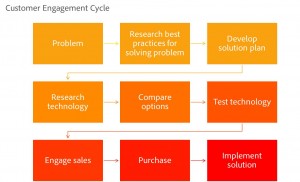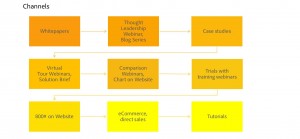While some marketers insist that webinars belong in only one stage of the customer buying journey, this belief is quickly becoming outdated. As my team at Adobe discovered in a recent study conducted with the Content Marketing Institute (CMI), more and more marketers are gaining value from webinars produced at several stages of the buying cycle – especially stages higher in the funnel. Webinars continue to be effective for lower funnel lead generation activities like demos and product tours; however, these are not the best first touch option for green prospects. Instead, highly effective marketers are successfully using webinars for thought leadership to attract, add value and build relationships with new prospects.
Webinars are a channel for delivering content and should be considered if interactivity will be beneficial for the content delivery. Let’s look at how to map webinars correctly to the buying journey.
Step 1) Map out buying stages
 If you have not already done so, you will want to study and document the typical stages that your buyers go through as they learn about, research and buy your product or service. What information do they need during stages such as discovery of a problem and researching a solution? How much information do they need before they are ready to reach out to you, the vendor? Do they need to trial your product first? Do they need pricing information? Do they need use case examples, demos or proof points from other similar customers?
If you have not already done so, you will want to study and document the typical stages that your buyers go through as they learn about, research and buy your product or service. What information do they need during stages such as discovery of a problem and researching a solution? How much information do they need before they are ready to reach out to you, the vendor? Do they need to trial your product first? Do they need pricing information? Do they need use case examples, demos or proof points from other similar customers?
You will need to understand all of their needs and the order of each of the stages they will go through before and after they engage with your sales team or purchase online. I have provided an example of a simplified buying journey here (click to view larger image).
Step 2) Determine content needed at each stage
Once you are confident that you understand your customer journey you will need to determine what content your customers need at each stage. Do your customers need awareness of a better way to do their job? Do they need help visualizing what the solution will look like from a practical implementation standpoint? Would it be helpful to provide a clear snapshot of how your product compares to the competition? Defining the content requirements for each of these stages is just the first piece of the puzzle here. Then you will need to take inventory of what content you have already that meets these needs as each stage and what is missing. If you are lucky, you have most of what you need already. If not, it’s time to get busy creating new content!
Step 3) Choose delivery channels
 Now you’re ready to decide how to deliver your content at each stage. You may even have several different pieces of content available to support each stage. How will you serve up each piece to your customers? There are several channels to choose from: whitepapers, case studies, videos, eBooks, live events, comparison guides, blogs, social media and, of course, webinars, to name a few. You can see that webinars are used throughout my example from the beginning to the end of the customer engagement cycle.
Now you’re ready to decide how to deliver your content at each stage. You may even have several different pieces of content available to support each stage. How will you serve up each piece to your customers? There are several channels to choose from: whitepapers, case studies, videos, eBooks, live events, comparison guides, blogs, social media and, of course, webinars, to name a few. You can see that webinars are used throughout my example from the beginning to the end of the customer engagement cycle.
Last word:
Now that you understand your customers’ journey and have all your content and channels mapped out, you need to find ways to deliver that content at the right time. Marketing automation systems are a great tool to ensure that your content is dished up at the best moment for each prospect during their buying journey. In addition to, or in lieu of, the use of a marketing automation system, simply ensure that you include a very clear call to action (CTA) at end of every piece of content you deliver. The CTA should lead them to the next stage of the buying journey, allowing buyers to accelerate themselves through the sales cycle. You may also want to make the next few steps obvious in case a motivated prospect is ready to accelerate faster than others.
REPORT – Webinars: They’re Not Just for Leads Anymore
